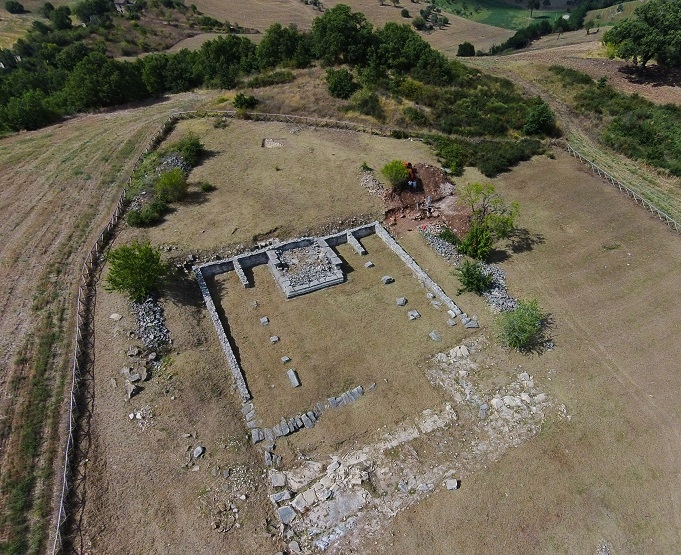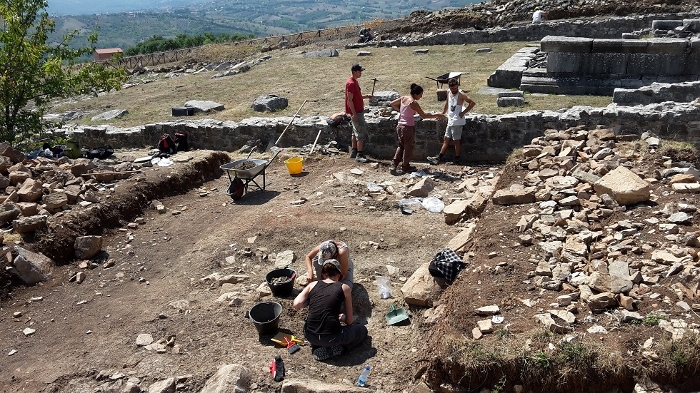Fieldwork campaign
Hellenistic-Roman Sanctuary Excavations (S. Giovanni in Galdo, Colle Rimontato, Molise, Italy)
Rural cult places were of central importance in the non-urbanised areas of ancient Samnium, in central southern Italy. Their development, roles and functions in ancient society, however, remain important research questions. New excavations at one of these sanctuaries, the rural temple of S. Giovanni in Galdo, Colle Rimontato, shed fresh light on the chronology, use and meaning of such cult sites.
- Duration
- 2011 - 2018
- Funding
-
 NWO Free Competion Grant
NWO Free Competion Grant
- Partners
Soprintendenza Archeologia del Molise
Centro Didattico Internazionale di Studi Archeologici di Jelsi
Introduction
The sanctuary of San Giovanni in Galdo, Colle Rimontato is located on top of a hill overseeing the valley of the Tappino River, in the Central-Southern area of Italy that in antiquity was known as Samnium. A small, yet monumental temple was established there in the Hellenistic period. Rural sanctuaries such as the San Giovanni temple are hypothesized to have fulfilled central roles for the non-urban, Samnite communities. The monumental phase has been excavated by the Soprintendenza in the 1970’s. The diachronic history and the role of the sanctuary in the wider settlement organization remained poorly understood, however. In order to answer these questions, new field research has been undertaken since 2004, which continues to yield important new data and insights.

In order to better understand the settlement organization of ancient Samnium and the role of sanctuaries within it, the Sacred Landscape Project was set up (2004-2010). Intensive field surveys in the area around the temple of S. Giovanni in Galdo as well as another sanctuary in the wider Tappino Valley, the temple of Cupa, GIldone, have revealed a dense rural settlement organization around the sanctuary, including a village, a necropolis, and farms. The hypothesis has thus been developed that rural sanctuaries such as S. Giovanni functioned primarily on a local scale, for a local rural community inhabiting the area around the cult site (Stek/Pelgrom 2005; Stek 2009 Chapter 5; Pelgrom/Stek 2010). Recently, the landscape archaeological research in the area has developed into the larger Tappino Area Archaeology Project (Stek 2015).

In order to better understand the long term history, use and architecture of the cult site as well as its direct environs, since 2012 new excavations are carried out by Leiden University in collaboration with the Superintendency of Molise. The excavations have brought to light new structures around the known temple site, and are providing a wealth of new data, including stratigraphically controlled ceramic assemblages that can be anchored with C14 dating. These findings prove very helpful for the understanding of the cult site, as well as other sites and contexts in the wider area.

The fieldwork experience
Research is carried out each year in one or more field campaigns by an enthusiastic international team of scholars and students. In addition to an intimate knowledge of the site, the landscape and its archaeology, they also get to know our friends in the local community of Jelsi, and the amazing food and wines of Molise and Italy. Crucial to our research in the area is the Centre of Archaeological Studies in Jelsi, that serves as base camp for the campaigns as well as many other didactic and outreach activities.
Publications
STEK, T.D. & PELGROM, J. 2005: Samnite sanctuaries surveyed. Preliminary report of the sacred landscape project 2004. BABESCH, 80, 65-71.
STEK, T.D. 2009: Cult places and cultural change in Republican Italy (Amsterdam, Amsterdam University Press), esp. Chapter 5.
PELGROM, J. & STEK, T.D. 2010: A landscape archaeological perspective on the functioning of a rural cult place in Samnium: field surveys around the sanctuary of S. Giovanni in Galdo (Molise). JAT, 20, 41-102.
STEK, T.D. 2015: The Importance of Rural Sanctuaries in Structuring Non-Urban Society in Ancient Samnium: Approaches from Architecture and Landscape. Oxford Journal of Archaeology, 34, 397-406.
